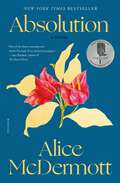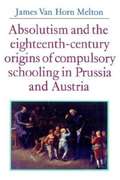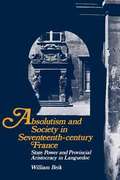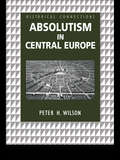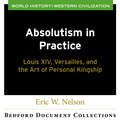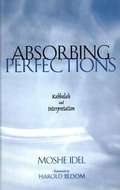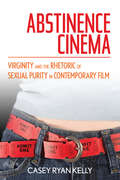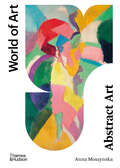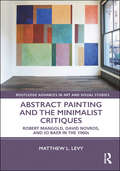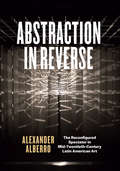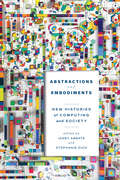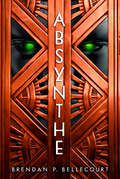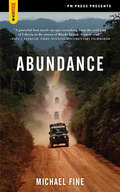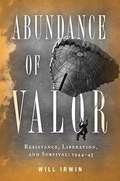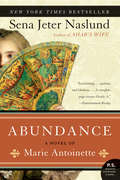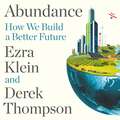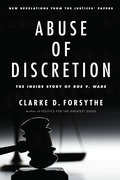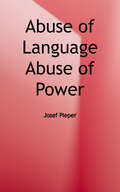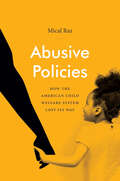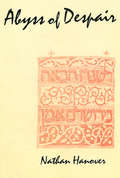- Table View
- List View
Absolution: A Novel
by Alice McDermottAN INSTANT NEW YORK TIMES BESTSELLERNamed a Best Book of the Year by Time, Esquire, Good Housekeeping, Kirkus Reviews, Los Angeles Times, NPR, Oprah Daily, Real Simple, and VogueA riveting account of women’s lives on the margins of the Vietnam War, from the renowned winner of the National Book Award.You have no idea what it was like. For us. The women, I mean. The wives.American women—American wives—have been mostly minor characters in the literature of the Vietnam War, but in Absolution they take center stage. Tricia is a shy newlywed, married to a rising attorney on loan to navy intelligence. Charlene is a practiced corporate spouse and mother of three, a beauty and a bully. In Saigon in 1963, the two women form a wary alliance as they balance the era’s mandate to be “helpmeets” to their ambitious husbands with their own inchoate impulse to “do good” for the people of Vietnam.Sixty years later, Charlene’s daughter, spurred by an encounter with an aging Vietnam vet, reaches out to Tricia. Together, they look back at their time in Saigon, taking wry account of that pivotal year and of Charlene’s altruistic machinations, and discovering how their own lives as women on the periphery—of politics, of history, of war, of their husbands’ convictions—have been shaped and burdened by the same sort of unintended consequences that followed America’s tragic interference in Southeast Asia.A virtuosic new novel from Alice McDermott, one of our most observant, most affecting writers, about folly and grace, obligation, sacrifice, and, finally, the quest for absolution in a broken world.
Absolutism And The Eighteenth-century Origins Of Compulsory Schooling In Prussia And Austria
by James Van Horn MeltonCompulsory schooling is widely held to be a creation of modern industrial society. Yet already in the eighteenth century, Prussian and Austrian rulers attempted to introduce universal education in societies that were overwhelmingly rural and 'premodern'. Focusing on the reigns of Frederick the Great of Prussia (1740–86) and Maria Theresa of Austria (1740–80), this 1988 book examines the origins, aims, and achievements of the compulsory school movements in those states. It draws on a broad range of sources in showing how school reform was part of a broader campaign to strengthen relationships of authority and dependence. Local resistance as well as the contradictory aims of absolutist rule severely limited the success of school reform. But in their effort to promote literate culture on an unprecedented scale, reformers established pedagogical institutions and practices that would decisively shape public education not only in Central Europe, but throughout the West.
Absolutism and Society In Seventeenth-Century France: State Power and Provincial Aristocracy in Languedoc
by William BeikWhy was Louis XIV successful in pacifying the same aristocrats who had caused so much trouble for Richelieu and Mazarin? What role did absolutism play in reinforming or changing the traditional social system in seventeenth-century France? In this analysis of the provincial reality of absolutism, Professor Beik argues that the answers to these questions lie in the relationship between the regional aristocracy and the crown. Starting with a critical examination of current approaches to state and society by institutional, social , 'Annales', and Marxist historians, he calls for a new class analysis based on the findings of all these schools. This is the first appearance as a paperback of Professor Beik's book, which won the 1986 Herbert Baxter Adams Prize awarded by the American historical Association for the year's outstanding work in European history.
Absolutism in Central Europe (Historical Connections)
by Peter WilsonAbsolutism in Central Europe is about the form of European monarchy known as absolutism, how it was defined by contemporaries, how it emerged and developed, and how it has been interpreted by historians, political and social scientists. This book investigates how scholars from a variety of disciplines have defined and explained political development across what was formerly known as the 'age of absolutism'. It assesses whether the term still has utility as a tool of analysis and it explores the wider ramifications of the process of state-formation from the experience of central Europe from the early seventeenth century to the start of the nineteenth.
Absolutism in Practice: Louis XIV, Versailles, and the Art of Personal Kingship (Bedford Document Collection )
by Eric W. NelsonThis document collection explores how Louis XIV sought to embody absolutism through his personal rule by examining the theory behind absolutism, Louis's own writings on kingship, and the observations of eyewitnesses at his court, shedding light on traditions of royal government in Europe since the Middle Ages. Students are guided through their analysis of the primary sources with an author-provided learning objective, central question, and historical context.
Absorbing Perfections: Kabbalah and Interpretation
by Moshe IdelThis book deals mainly with material found in a vast body of literature designated by its authors and by modern scholars as Kabbalah. Basically a medieval corpus, this literature consists of a variety of schools, trends, models, ideals, and techniques.
Abstinence Cinema: Virginity and the Rhetoric of Sexual Purity in Contemporary Film
by Casey Ryan KellyFrom the perspective of cultural conservatives, Hollywood movies are cesspools of vice, exposing impressionable viewers to pernicious sexually-permissive messages. Offering a groundbreaking study of Hollywood films produced since 2000, Abstinence Cinema comes to a very different conclusion, finding echoes of the evangelical movement's abstinence-only rhetoric in everything from Easy A to Taken. Casey Ryan Kelly tracks the surprising sex-negative turn that Hollywood films have taken, associating premarital sex with shame and degradation, while romanticizing traditional nuclear families, courtship rituals, and gender roles. As he demonstrates, these movies are particularly disempowering for young women, concocting plots in which the decision to refrain from sex until marriage is the young woman's primary source of agency and arbiter of moral worth. Locating these regressive sexual politics not only in expected sites, like the Twilight films, but surprising ones, like the raunchy comedies of Judd Apatow, Kelly makes a compelling case that Hollywood films have taken a significant step backward in recent years. Abstinence Cinema offers close readings of movies from a wide spectrum of genres, and it puts these films into conversation with rhetoric that has emerged in other arenas of American culture. Challenging assumptions that we are living in a more liberated era, the book sounds a warning bell about the powerful cultural forces that seek to demonize sexuality and curtail female sexual agency.
Abstract Art: Second Edition (World of Art #0)
by Anna MoszynskaAn exceptionally clear, thorough, and well- illustrated introduction to abstract art since 1900. Since the early years of the twentieth century, Western abstract art has fascinated, outraged, and bewildered audiences. Its path to acceptance within the artistic mainstream was slow. This revised edition traces the origins and evolution of abstract art, placing it in broad cultural context. Well-respected scholar Anna Moszynska examines the pioneering work of Hilma af Klint, Wassily Kandinsky, Kazimir Malevich, and Piet Mondrian alongside the Russian Constructivists, the De Stijl group, and the Bauhaus artists, contrasting European geometric abstraction in the 1930s and ’40s with the emphasis on personal expression after World War II. Op, kinetic, and minimal art of the postwar period is discussed and illustrated in detail, and new chapters bring the account up to date, exploring the crisis in abstraction of the 1980s and its revival—in paint, fabric, sculpture, and installation—in recent decades. The first edition of Abstract Art, published in 1990, was acclaimed by reviewers. Revised with extensive updates, this book includes new chapters on recent trends and offers fully global coverage of art produced in North and South America, Europe, China, Korea, and the Middle East. Now in full color and comprehensively revised, it will serve as the best introduction to abstract art for a new generation.
Abstract Painting and the Minimalist Critiques: Robert Mangold, David Novros, and Jo Baer in the 1960s (Routledge Advances in Art and Visual Studies)
by Matthew L. LevyThis book undertakes a critical reappraisal of Minimalism through an examination of three key painters: Robert Mangold, David Novros, and Jo Baer. By establishing their substantive engagements with Minimalist discourse, as well as their often overlooked artistic exchanges with their sculptor peers, it demonstrates that painting crucially informed the movement’s development, serving not only as an object of critique but also as a crucible for its most central tenets. It also poses broader disciplinary implications as it historicizes and challenges Minimalism’s "death of painting" critiques that have been so influential to theories of modernism and postmodernism in the visual arts.
Abstract Video: The Moving Image in Contemporary Art
by Gabrielle JenningsOffering historical and theoretical positions from a variety of art historians, artists, curators, and writers, this groundbreaking collection is the first substantive sourcebook on abstraction in moving-image media. With a particular focus on art since 2000, Abstract Video addresses a longer history of experimentation in video, net art, installation, new media, expanded cinema, visual music, and experimental film. Editor Gabrielle Jennings—a video artist herself—reveals as never before how works of abstract video are not merely, as the renowned curator Kirk Varnedoe once put it, "pictures of nothing," but rather amorphous, ungovernable spaces that encourage contemplation and innovation. In explorations of the work of celebrated artists such as Jeremy Blake, Mona Hatoum, Pierre Huyghe, Ryoji Ikeda, Takeshi Murata, Diana Thater, and Jennifer West, alongside emerging artists, this volume presents fresh and vigorous perspectives on a burgeoning and ever-changing arena of contemporary art.
Abstraction in Reverse: The Reconfigured Spectator in Mid-Twentieth-Century Latin American Art
by Alexander AlberroDuring the mid-twentieth century, Latin American artists working in several different cities radically altered the nature of modern art. Reimagining the relationship of art to its public, these artists granted the spectator an unprecedented role in the realization of the artwork. The first book to explore this phenomenon on an international scale, Abstraction in Reverse traces the movement as it evolved across South America and parts of Europe. Alexander Alberro demonstrates that artists such as Tomás Maldonado, Jesús Soto, Julio Le Parc, and Lygia Clark, in breaking with the core tenets of the form of abstract art known as Concrete art, redefined the role of both the artist and the spectator. Instead of manufacturing autonomous art, these artists produced artworks that required the presence of the spectator to be complete. Alberro also shows the various ways these artists strategically demoted regionalism in favor of a new modernist voice that transcended the traditions of the nation-state and contributed to a nascent globalization of the art world.
Abstractions and Embodiments: New Histories of Computing and Society (Studies in Computing and Culture)
by Janet Abbate and Stephanie DickCutting-edge historians explore ideas, communities, and technologies around modern computing to explore how computers mediate social relations.Computers have been framed both as a mirror for the human mind and as an irreducible other that humanness is defined against, depending on different historical definitions of "humanness." They can serve both liberation and control because some people's freedom has historically been predicated on controlling others. Historians of computing return again and again to these contradictions, as they often reveal deeper structures.Using twin frameworks of abstraction and embodiment, a reformulation of the old mind-body dichotomy, this anthology examines how social relations are enacted in and through computing. The authors examining "Abstraction" revisit central concepts in computing, including "algorithm," "program," "clone," and "risk." In doing so, they demonstrate how the meanings of these terms reflect power relations and social identities. The section on "Embodiments" focuses on sensory aspects of using computers as well as the ways in which gender, race, and other identities have shaped the opportunities and embodied experiences of computer workers and users. Offering a rich and diverse set of studies in new areas, the book explores such disparate themes as disability, the influence of the punk movement, working mothers as technical innovators, and gaming behind the Iron Curtain. Abstractions and Embodiments reimagines computing history by questioning canonical interpretations, foregrounding new actors and contexts, and highlighting neglected aspects of computing as an embodied experience. It makes the profound case that both technology and the body are culturally shaped and that there can be no clear distinction between social, intellectual, and technical aspects of computing. Contributors: Janet Abbate, Marc Aidinoff, Troy Kaighin Astarte, Ekaterina Babinsteva, André Brock, Maarten Bullynck, Jiahui Chan, Gerardo Con Diaz, Liesbeth De Mol, Stephanie Dick, Kelcey Gibbons, Elyse Graham, Michael J. Halvorson, Mar Hicks, Scott Kushner, Xiaochang Li, Zachary Loeb, Lisa Nakamura, Tiffany Nichols, Laine Nooney, Elizabeth Petrick, Cierra Robson, Hallam Stevens, Jaroslav Švelch
Absynthe
by Brendan P. BellecourtIn his sci-fi debut, Bellecourt explores an alternate roaring 20s where a shell-shocked soldier must uncover latent telepathic abilities to save himself and the people around him.Liam Mulcahey, a reclusive, shell-shocked veteran, remembers little of the Great War. Ten years later, when he is caught in a brutal attack on a Chicago speakeasy, Liam is saved by Grace, an alluring heiress who's able to cast illusions. Though the attack appears to have been committed by the hated Uprising, Grace believes it was orchestrated by Leland De Pere--Liam's former commander and the current President of the United States. Meeting Grace unearths long-buried memories. Liam's former squad, the Devil's Henchmen, was given a serum to allow telepathic communication, transforming them into a unified killing machine. With Grace's help, Liam begins to regain his abilities, but when De Pere learns of it, he orders his militia to eliminate Liam at any cost. But Liam's abilities are expanding quickly. When Liam turns the tables and digs deeper into De Pere's plans, he discovers a terrible secret. The same experiment that granted Liam's abilities was bent toward darker purposes. Liam must navigate both his enemies and supposed allies to stop the President's nefarious plans before they're unleashed on the world. And Grace is hiding secrets of her own, secrets that could prove every bit as dangerous as the President's.
Abu Hanifah
by Mohammed Akram NadwiAbu Hanifah Nu'man ibn Thabit was one of the greatest pioneers in the history of Islamic Law, particularly in legal reasoning. The Hanafi Legal School that he founded has become the most widely followed among the world's Muslims. Based on primary sources, this study of the life and legacy of Abu Hanifah also surveys the evolution of Hanafi legal reasoning (fiqh) in different regions of the Islamic world and assesses its historical distinctiveness.Mohammed Akram Nadwi is a research fellow at the Oxford Centre for Islamic Studies, and is the author of several works including al-Muhaddithat: the Women Scholars in Islam (2007).
Abu Nidal: A Gun for Hire
by Patrick SealeBritish journalist Seale, distinguished as a Middle East specialist, details the Arab terrorist's career, the sources of his vast personal fortune, the motives behind his acts of terrorism and his ties to various Middle East and European governments.
Abul Kalam Azad
by Abdul Kavi DasnaviAbul Kalam Azad was one of the most important figure of India's struggle for freedom. He organised the masses against the British Empire. His life was dedicated to the nation and its development. He spent almost ten years of life in jail but that did not deter him from fighting it out and make Indians stronger than ever.
Abundance (Spectacular Fiction)
by Michael FineJulia is an American medical doctor fleeing her own privileged background todeliver health care to remote African communities, where her skills really make a difference. Carl is also an American, whose experiences as a black man in the United States have led him to volunteer in Africa. The two come together as colleagues (and lovers) as Liberia is gripped in a brutal civil war. Then Julia is kidnapped by child soldiers on a remote jungle road, and Carl is "rescued" and evacuated against his will by U.S. Marines. Back in the U.S., Carl turns to a Rhode Island doctor who has been a mentor to them both. With the help of a smuggler, they return to Africa illegally and begin the dangerous work of finding and rescuing Julia. This is an unforgettable thriller grounded in real events. A short preface and several appendices add background on Liberia's complex U.S.-linked history, and a glossary illuminates Liberia's colorful Kreyol patois.
Abundance of Valor: Resistance, Survival, and Liberation - 1944–45
by Will IrwinThe operation known as “Market Garden”—made famous in the book and film A Bridge Too Far—was the largest airborne assault in history up to that time, a high-risk Allied invasion of enemy territory that has become a legend of World War II, even as it still invites criticism from historians. Now a thrilling and revelatory new book re-creates the operation as never before, revealing for the first time the full adventures of the bold “Jedburgh” paratroopers whose exploits were almost unimaginably risky and heroic. Kicked off on September 17, 1944, Market Garden was intended to secure crucial bridges in the Nazi-occupied Netherlands by a parachute assault conducted by three Allied airborne divisions. Capture of the bridges would allow a swift advance and crossing of the Rhine by British ground forces. Jedburgh teams—Allied Special Forces—were dropped into the Netherlands to train and use the Dutch resistance in support of the larger operation. Based on new firsthand testimony of survivors and declassified documents, Abundance of Valor concentrates on the three teams that operated farthest behind enemy lines, the nine men whose treacherous missions resulted in deaths, captures, and hair-breadth escapes. Here in unprecedented detail are the heat and stench of fuel, oil, and sweat in the troop carriers going over, the remarkable (and misleading) initial success of the daylight parachute landings, and the deadly, brutally effective German response, particularly by crack SS armored units in the blood-soaked town of Arnhem. Abundance of Valor portrays with stunning verisimilitude the experiences of Lt. Harvey Allan Todd, who fought from a surrounded position against overwhelming numbers of the enemy before surviving capture, near-starvation, interrogation, and solitary confinement in German POW camps, and Maj. John “Pappy” Olmsted, who made a hazardous journey, in disguise, from safe house to safe house through enemy territory until finally reaching friendly lines.
Abundance: A Novel of Marie Antoinette
by Sena Jeter NaslundMarie Antoinette was a child of fourteen when her mother, the Empress of Austria, arranged for her to leave her family and her country to become the wife of the fifteen-year-old Dauphin, the future King of France. Coming of age in the most public of arenas--eager to be a good wife and strong queen--she warmly embraces her adopted nation and its citizens. She shows her new husband nothing but love and encouragement, though he repeatedly fails to consummate their marriage and in so doing is unable to give what she and the people of France desire most: a child and an heir to the throne. Deeply disappointed and isolated in her own intimate circle, and apart from the social life of the court, she allows herself to remain ignorant of the country's growing economic and political crises, even as poor harvests, bitter winters, war debts, and poverty precipitate rebellion and revenge. The young queen, once beloved by the common folk, becomes a target of scorn, cruelty, and hatred as she, the court's nobles, and the rest of the royal family are caught up in the nightmarish violence of a murderous time called "the Terror." With penetrating insight and with wondrous narrative skill, Sena Jeter Naslund offers an intimate, fresh, heartbreaking, and dramatic reimagining of this truly compelling woman that goes far beyond popular myth--and she makes a bygone time of tumultuous change as real to us as the one we are living in now.
Abundance: How We Build a Better Future
by Derek Thompson Ezra KleinA FINANCIAL TIMES TOP PICK OF 2025The real threat to liberal democracy isn't just from autocrats - but from a lack of effective action by so-called progressives.We have the means to build an equitable world without hunger, fuelled by clean energy. Instead, we have a politics driven by scarcity, lives defined by unaffordability and public institutions that no longer deliver on big ideas. It's time for change.Bestselling authors Ezra Klein and Derek Thompson have spent decades analysing the political, economic and cultural forces that have led us here. In this once in a generation intervention, they unpick the barriers to progress and show how we can, and must, shift the political agenda to one that not only protects and preserves, but also builds. From healthcare to housing, infrastructure to innovation thy lay out a path to a futuredefined not by fear, but by abundance.
Abuse of Discretion
by Clarke D. ForsytheBased on 20 years of research, including an examination of the papers of eight of the nine Justices who voted in Roe v. Wade and Doe v. Bolton, Abuse of Discretion is a critical review of the behind-the-scenes deliberations that went into the Supreme Court's abortion decisions and how the mistakes made by the Justices in 1971-1973 have led to the turmoil we see today in legislation, politics, and public health. The first half of the book looks at the mistakes made by the Justices, based on the case files, the oral arguments, and the Justices' papers. The second half of the book critically examines the unintended consequences of the abortion decisions in law, politics, and women's health.Why do the abortion decisions remain so controversial after almost 40 years, despite more than 50,000,000 abortions, numerous presidential elections, and a complete turnover in the Justices? Why did such a sweeping decision-with such important consequences for public health, producing such prolonged political turmoil-come from the Supreme Court in 1973? Answering those questions is the aim of this book. The controversy over the abortion decisions has hardly subsided, and the reasons why are to be found in the Justices' deliberations in 1971-1972 that resulted in the unprecedented decision they issued.Discuss Abuse of Discretion on Twitter using hashtag #AbuseOfDiscretion.
Abuse of Language, Abuse of Power
by Josef PieperOne of the great Catholic philosophers of our day reflects on the way language has been abused so that, instead of being a means of communicating the truth and entering more deeply into it, and of the acquisition of wisdom, it is being used to control people and manipulate them to achieve practical ends. Reality becomes intelligible through words. Man speaks so that through naming things, what is real may become intelligible. This mediating character of language, however, is being increasingly corrupted. Tyranny, propaganda, mass-media destroy and distort words. They offer us apparent realities whose fictive character threatens to become opaque. Josef Pieper shows with energetic zeal, but also with ascetical restraint, the path out of this dangerous situation. We are constrained to see things again as they are and from the truth thus grasped, to live and to work.
Abused Bodies in Roman Epic
by Andrew M. McClellanGreco-Roman martial epic poetry, from Homer and Virgil to Neronian and Flavian epic, is obsessed with the treatment of dead bodies. Sometimes corpses take centre-stage in grand funerals; sometimes, disturbingly, they are objects of physical violence or malign neglect. In this book - the first full-length examination of corpse mistreatment in epic - Andrew M. McClellan explores the motif of post mortem abuse in Greco-Roman epic, especially the Latin poems of early imperial Rome: Lucan's Bellum ciuile, Valerius Flaccus' Argonautica, Statius' Thebaid, and Silius' Punica. He counters the pervasive tendency to view epic violence from the perspective of the abuser by shifting the focus to the object of abuse. In signalling the corpse as a critical 'character' and not simply a by-product of war, he offers a fundamental re-evaluation of violence and warfare in Latin epic, and through close study of intertextualities indicates the distinctive features of each author's treatment of the dead.
Abusive Policies: How the American Child Welfare System Lost Its Way (Studies in Social Medicine)
by Mical RazIn the early 1970s, a new wave of public service announcements urged parents to "help end an American tradition" of child abuse. The message, relayed repeatedly over television and radio, urged abusive parents to seek help. Support groups for parents, including Parents Anonymous, proliferated across the country to deal with the seemingly burgeoning crisis. At the same time, an ever-increasing number of abused children were reported to child welfare agencies, due in part to an expansion of mandatory reporting laws and the creation of reporting hotlines across the nation. Here, Mical Raz examines this history of child abuse policy and charts how it changed since the late 1960s, specifically taking into account the frequency with which agencies removed African American children from their homes and placed them in foster care. Highlighting the rise of Parents Anonymous and connecting their activism to the sexual abuse moral panic that swept the country in the 1980s, Raz argues that these panics and policies—as well as biased viewpoints regarding race, class, and gender—played a powerful role shaping perceptions of child abuse. These perceptions were often directly at odds with the available data and disproportionately targeted poor African American families above others.
Abyss of Despair
by Nathan HanoverProviding a gripping, first-hand account of the Chmielnicki massacres in 1648-58, in which tens of thousands of Jews perished in Poland and the Ukraine, Rabbi Nathan Hanover describes the events themselves and their effect on European Jewry. Hanover's description of the atrocities commited* by Chmielnicki and his hordes makes it clear that they set the precedent for Hitler's torture chambers. Hanover's account of the events understood in their historical context 'shows how humans can transcend tragedy and rebuild their lives, developing new ways to express their heritage and culture. Professor Helmreich, in his new introduction, describes the- period of relative peace and prosperity for the Jews immediately preceding the massacres. He traces some of the important effects the massacre had on later Jewish history, such as the rise of Messianic and Hasidic movements in the seventeenth and eighteenth centuries and the migration of Jews back toward the west, where they were situated when the Enlightenment swept through Europe.
